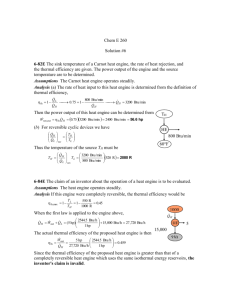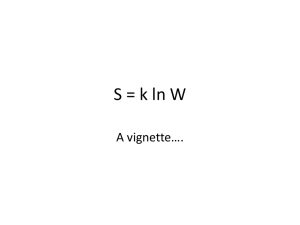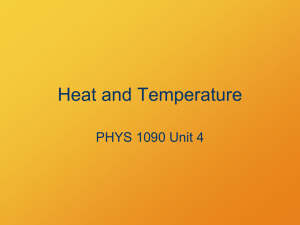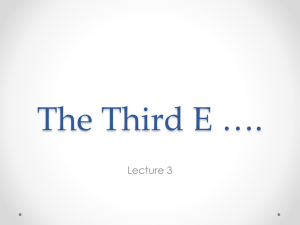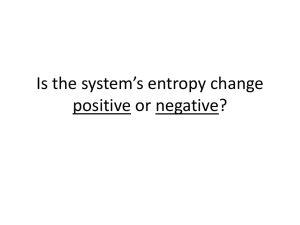Lecture 24: Introduction to Entropy
advertisement
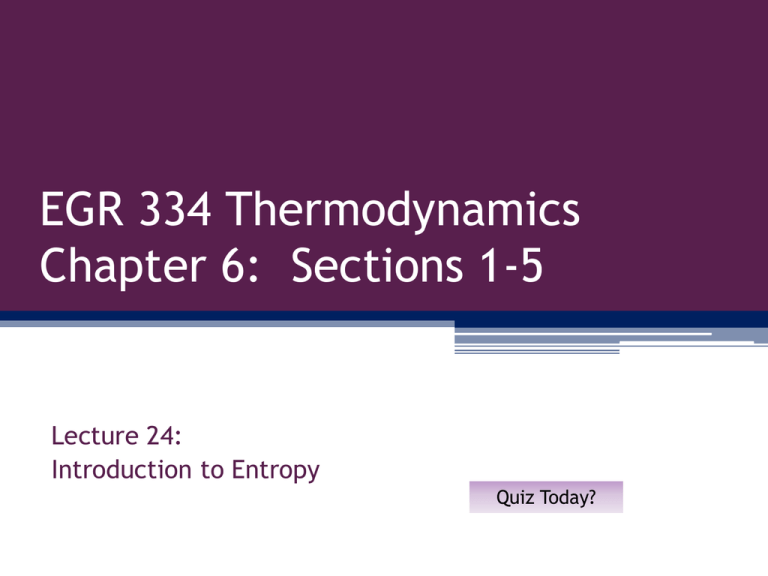
EGR 334 Thermodynamics Chapter 6: Sections 1-5 Lecture 24: Introduction to Entropy Quiz Today? Today’s main concepts: • • • • Explain key concepts about entropy Learn how to evaluate entropy using property tables Learn how to evaluate changes of entropy over reversible processes Introduction of the temperature-entropy (T-s) diagram Reading Assignment: Read Chapter 6, Sections 6-8 Homework Assignment: Problems from Chap 6: 1,11,21,28 Introducing Entropy Change and the Entropy Balance • The entropy change and entropy balance concepts are developed using the Clausius inequality expressed as: Q s T b cycle where scycle = 0 no irreversibilities present within the system scycle > 0 irreversibilities present within the system scycle < 0 impossible Defining Entropy Change • Consider two cycles, each composed of two internally reversible processes, process A plus process C and process B plus process C, as shown in the figure. • Applying Classius Equation to these cycles gives, where scycle is zero because the cycles are composed of internally reversible processes. Defining Entropy Change • Subtracting these equations: • Since A and B are arbitrary internally reversible processes linking states 1 and 2, it follows that the value of the integral is independent of the particular internally reversible process and depends on the end states only. Defining Entropy Change • Recalling (from Sec. 1.3.3) that a quantity is a property if, and only if, its change in value between two states is independent of the process linking the two states, we conclude that the integral represents the change in some property of the system. • We call this property entropy and represent it by S. The change in entropy is 2 Q S 2 S1 1 T int rev where the subscript “int rev” signals that the integral is carried out for any internally reversible process linking states 1 and 2. Defining Entropy Change Q S2 S1 1 T int rev 2 • The equation allows the change in entropy between two states to be determined by thinking of an internally reversible process between the two states. But since entropy is a property, that value of entropy change applies to any process between the states – internally reversible or not. Entropy Facts • Entropy is an extensive property. • Like any other extensive property, the change in entropy can be positive, negative, or zero: • Units of entropy, S, are: in SI in US Customary • Units for specific entropy, s, are: in SI in US Customary [kJ/K] [Btu/oR] [kJ/kg-K] [Btu/lbm-oR] Finding Entropy: Method 1 ►For problem solving, specific entropy values are provided in Tables A-2 through A-18. Values for specific entropy are obtained from these tables using the same procedures as for specific volume, internal energy, and enthalpy. For two phase liquid/vapor mixtures, quality, x, may be used as x s sf sg s f or s s f x( sg s f ) For slightly compressed liquids, the entropy may be approximated as: s (T , p) s f (T ) Example 1: find s using property tables a) Given: H20 at T=520 oC and p= 8 MPa find s: From Table A-2…substance is found to be superheated vapor. From Table A-4…..s can be found ad 6.7871 kJ/kg-K b) Given: Ammonia at p =2.5 bar and v = 0.20 m3/kg find s: From Table A14…substance is found to be liquid/vapor mixture. the quality can be found as x (v v f ) /(vg v f ) (0.20 .0015) /(0.4821 0.0015) 0.413 and then s s f x( sg s f ) 0.4753 0.413(5.5190 0.4753) 2.5583kJ / kg K c) Given: R22 at T = 20 oF and p = 80 psi find s: From Table A-7E or A-8E…substance is found to be compressed liquid then s can be found using s(T,p)=sf(T) = 0.0356 Btu/lbm-oR 10 11 Example (6.4): Using the appropriate tables determine the change in specific enthalpy between the specified states, in BTU/lb·°R. (a) Water p1 = 1000 psi, T1 = 800 °F p2 = 1000 psi, T2 = 1000 °F (b) Refrigerant 134a h1 = 47.91 BTU/lb, T1 = -40 °F saturated vapor, p2 = 40 psi 12 Example (6.4): Using the appropriate tables determine the change in specific enthalpy between the specified states, in BTU/lb·°R. (a) Water p1 = 1000 psi, T1 = 800 °F p2 = 1000 psi, T2 = 100 °F T 1000 psi 1 545°F 2 v Table A-4E @ T1 = 800 °F, p1 = 1000 psi s1 = 1.5665 BTU/lb·°R Table A-5E @ T2 = 100 °F, p2 = 1000 psi s2 = 0.12901 BTU/lb·°R s2 - s1 = 0.12901 - 1.5665 = -1.43749 BTU/lb·°R 13 Example (6.4): Using the appropriate tables determine the change in specific enthalpy between the specified states, in BTU/lb·°R. (b) Refrigerant 134a h1 = 47.91 BTU/lb, T1 = -40 °F saturated vapor, p2 = 40 psi T Table A-10E, @ T1 = -40 °F hf=0, hg=95.82 BTU/lb 47 .91 0 x 0.5 95 .82 0 2 -40°F 1 v Table A-11E, sat. vapor, p2 = 40 psi s2 0.2197 Btu / lbm R sf=0, sg=0.2283 BTU/lb·°R s1 s f x sg s f 0 0.5 0.2283 0 0.1142 Btu / lbm R s2 - s1 = 0.2197 - 0.11415 = 0.1056 BTU/lb·°R Finding Entropy: Method 2 • For problem solving, states often are shown on property diagrams having specific entropy as a coordinate: the Temperature-Entropy (T-s) diagram and the Enthalpy-Entropy (h-s) diagram • the h-s diagram is also know as the Mollier diagram These diagrams are in your appendix as Figures 7 and 8 and Figures 7E and 8E. T-s diagram: Vertical axis: Temperature Horizontal axis: Entropy Shows other constant property lines: Constant Pressure Constant Quality Constant Enthalpy Constant Specific Volume h-s diagram: Vertical axis: Enthalpy Horizontal axis: Entropy Shows other constant property lines: Constant Temperature Constant Pressure Constant Quality Example 2: Using T-s diagram: a) Given: H20 at T=900 oF and h = 1400 Btu/lbm find s: s ≈ 1.5 Btu/lbm-R From Table A-7E or A-8E…substance is found to be compressed liquid then s can be found using s(T,p)=sf(T) = 0.0356 Btu/lbm-oR b) Given: H20 at s=1.5 Btu/lbm-R and x=85% find h: h ≈ 1.5 Btu/lbm From Table A-7E or A-8E…substance is found to be compressed liquid then s can be found using s(T,p)=sf(T) = 0.0356 Btu/lbm-oR 17 Finding Entropy: Method 3…IT IT can also be used for working with entropy. Once again it’s recommended that you don’t compare individual values from IT with the values you might find on the Appendix tables from you book, but changes in entropy between two states will be consistent and can be compared. For H20, find the difference in entropy between State 1: T = 500 deg C and p = 20 bar State 2: T = 200 deg C and p = 10 bar Δs=0.1992 kJ/kg-K Sec 6.3 : The TdS Equations 19 How is S related to U? Consider a pure, simple, compressible system undergoing a internally reversible process. Energy Balance: KE PE U Q W U Q W then differentiate where, therefore, dU Qint rev W int rev W int rev pdV Q int rev TdS dU TdS pdV TdS dU pdV 1st TdS equation Sec 6.3 : The TdS Equations 20 How is S related to H? Recall that: H U pV dH dU d pV dU pdV Vdp dU pdV dH Vdp and dU TdS pdV from 1st Tds equation TdS dU pdV therefore, TdS dH Vdp 2nd T dS equation can also write these on a per mass basis du Tds pdv dh Tds vdp Relationships between p, T, v, u, h, and s Even though this derivation is based on a reversible process, these equations hold for any process… even an irreversible process. Finding Entropy: Method 4 for incompressible fluid When a substance is compressible (like many liquids), du Tds pdv du pdv ds T T Recall that for incompressible fluids: du c dT dv 0 and where c is the specific heat capacity then cdT ds T s2 s1 c dT T if the specific heat is treated as constant T2 dT s2 s1 c c ln 1 T T Δs for incompressible liquids Finding Entropy: Method 5 for Ideal Gas Recall that if a substance can be treated as an ideal gas, the following relationships may be applied to the defining the properties: pv RT du cv dT k c p / cv dh c p dT c p cv R Combining ideal gas relations with the Tds equations du pdv ds T T dh vdp ds T T dT dv ds cv R T v dT dp ds c p R T p give ds = f(T,v) ds = f(T,p) Sec 6.4 Idea Gases 23 So for Ideal Gas, change in entropy can be evaluated by integrating these relations cv T dT R ds dv T v and cP T dT R ds dp T P v2 cV T dT s R ln T v1 cP T dT p2 s R ln T p 1 Sec 6.4 Idea Gases 24 Options to evaluate: v2 cV T dT s R ln T v1 and cP T dT p2 s R ln T p 1 there are several options to evaluate the heat capacity. Remember that cV & cP are functions of temperature. i) Find values for cp and or cv (Using Table A21) cP T T 2 T 3 T 4 or constant heat capacities from Tables A20, A22, or A23. cv R k 1 or cP kR k 1 then use or p v T T s c p ln 2 R ln 2 s cv ln 2 R ln 2 T1 T1 p1 v1 ii) Use Tabulated values( Table A22): s sT2 sT1 The s° indicates that it is based on a reference temp p2 s s T2 s T1 R ln p 1 25 Example (6.4): Using the appropriate tables determine the change in specific enthalpy between the specified states, in BTU/lb·°R. Air as an ideal gas with T1 = 40°F = 500° R , p1 = 2 atm and T2 = 420°F = 880° R, p2 = 1 atm (a) using a constant cv at Tave cP T dT p2 s R ln T p1 T2 s cP ln T1 where: Tave = 230 F = 690 R R = 0.06855 Btu/lb-R p2 R ln p 1 cp = 0.242 Btu/lb-R 880 1 o s 0.242 ln 0.06855 ln 0.1843 Btu / R 500 2 26 Example (6.4): Using the appropriate tables determine the change in specific enthalpy between the specified states, in BTU/lb·°R. Air as an ideal gas with T1 = 40°F = 500° R , p1 = 2 atm and T2 = 420°F = 880° R, p2 = 1 atm (c) Air as an ideal gas using so P2 s sT2 sT1 R ln P1 from Table A-22E @ T1 = 500 °R, s° = 0.58233 BTU/lb·°R @ T2 = 880 °R, s° = 0.71886 BTU/lb·°R 1 atm s 0.71886 0.58233 0.06855 ln 2 atm BTU s 0.1841 lb R 27 end of lecture 24 slides

